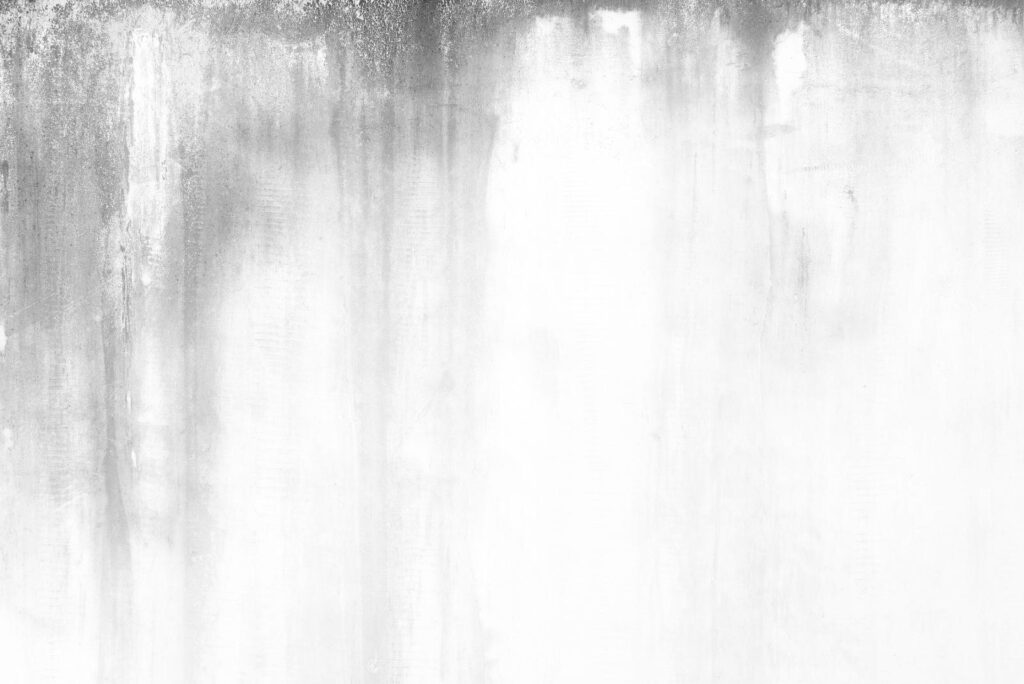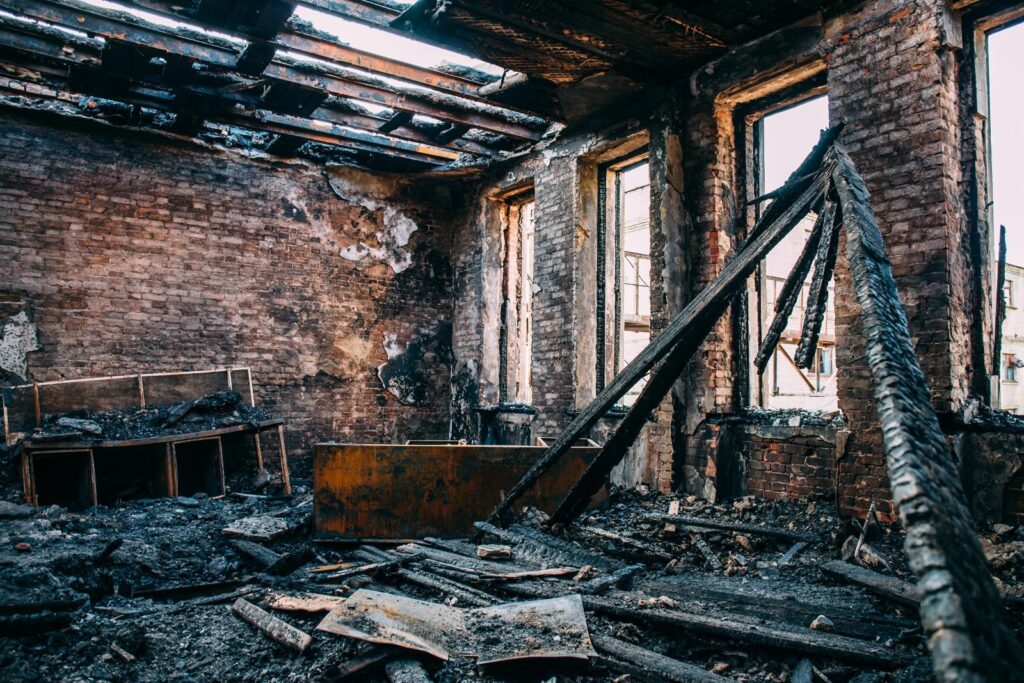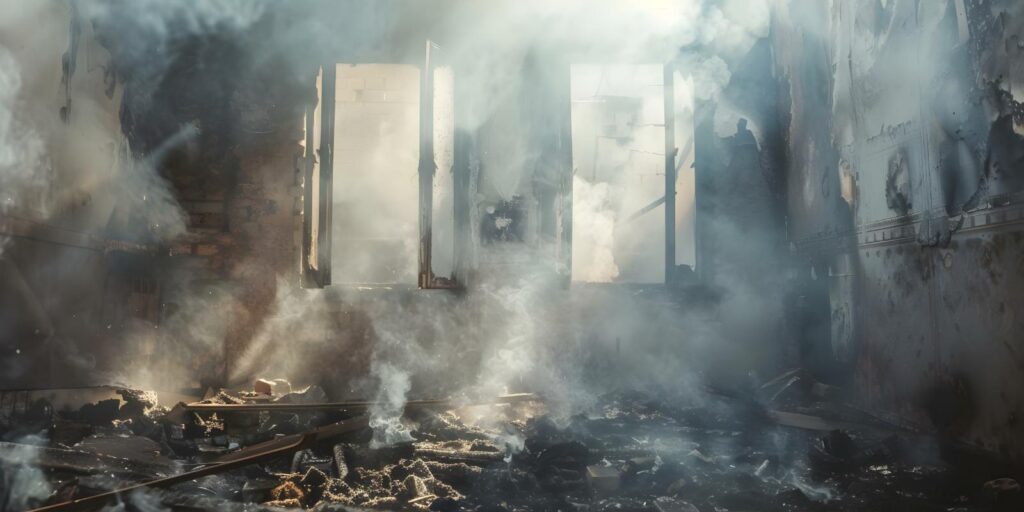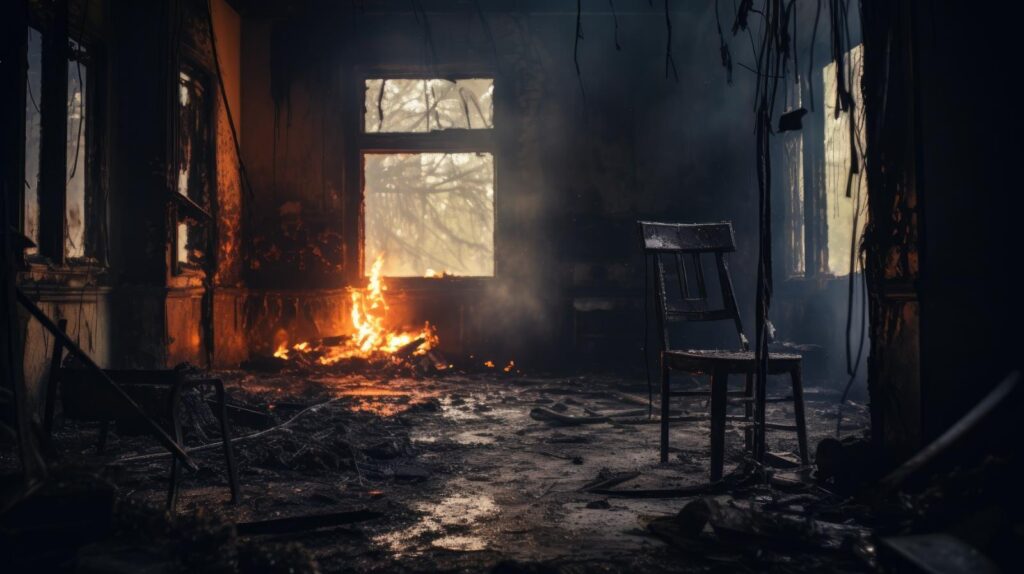
Contents
After flooding, dealing with mold can feel overwhelming, but you can tackle it effectively by following some key steps. Start by assessing the damage and ensuring your safety—these are crucial first moves. Once you’ve done that, you’ll need to act quickly to remove standing water and reduce humidity in the area. Understanding how to identify mold-prone spots and what products to use makes a significant difference. But, are you prepared for the full scope of the process? Let’s explore the essential steps to ensure your environment is mold-free.
Key Takeaways
- Assess the damage and ensure personal safety by wearing protective gear and checking for structural stability before beginning cleanup.
- Remove standing water promptly using pumps or wet/dry vacuums, prioritizing safety by turning off electricity in affected areas.
- Ventilate the area by opening windows, using fans, and employing dehumidifiers to promote air circulation and expedite drying.
- Identify and clean mold-prone areas using appropriate mold removal solutions and ensure thorough drying to prevent regrowth.
- Monitor for mold recurrence with regular inspections and maintain indoor humidity levels between 30%-50% to deter mold growth.
Assess the Damage
Before you begin the mold removal process, it’s crucial to assess the damage caused by flooding. Understanding the flood impact on your property will help you determine the extent of mold growth and the necessary steps for remediation.
Start by inspecting the affected areas carefully. Look for visible signs of water damage, such as discoloration on walls, ceilings, and floors, which often indicate moisture retention.
Next, evaluate materials that may have absorbed water, including carpets, drywall, and insulation. These materials are particularly vulnerable to mold growth. Use a moisture meter to check humidity levels in different areas. If readings exceed recommended levels, it’s a clear indication that you need to act quickly.
Document your findings during the damage assessment process. Take photos and notes to create a record. This documentation can be essential for insurance claims and any future repairs. Be thorough; sometimes, mold can develop in hidden spaces like behind walls or under floorboards.
Also, consider the duration of water exposure. The longer materials remain wet, the higher the risk of mold growth. If your property has been flooded for more than 24 hours, the likelihood of mold infestation increases significantly.
Lastly, consult professionals if the damage appears extensive. They can provide expertise in assessing the damage and recommend appropriate remediation strategies.
Ensure Personal Safety
Before you start mold removal, it’s critical to wear protective gear, including gloves, masks, and goggles, to safeguard yourself from harmful spores.
Additionally, assess the structural stability of the affected areas to ensure it’s safe to proceed.
Prioritizing your safety will help prevent injuries and health risks during the cleanup process.
Wear Protective Gear
When tackling mold removal after flooding, donning the right protective gear is crucial for your safety. Mold can pose serious health risks, so it’s essential to shield yourself effectively. Start with protective clothing that covers your arms and legs, minimizing skin exposure. A long-sleeved shirt, long pants, and closed-toe shoes should be your first line of defense.
Next, safety goggles are vital to protect your eyes from mold spores and irritants. A mask rated for mold, such as an N95 respirator, helps filter out harmful particles you might inhale.
Here’s a quick reference table to remind you of essential protective gear:
| Gear Type | Purpose |
|---|---|
| Protective Clothing | Shields skin from mold and contaminants |
| Safety Goggles | Protects eyes from mold spores and irritants |
| N95 Respirator | Filters harmful particles from the air |
| Gloves | Prevents direct contact with mold |
| Protective Footwear | Keeps feet safe from contaminated surfaces |
Assess Structural Stability
After you’ve geared up for protection, the next step is to assess the structural stability of your home. This is crucial for ensuring your safety and determining the extent of flood damage.
Start by inspecting the foundation for cracks or signs of settling. Look for warped walls, sagging ceilings, or displaced doors, as these may indicate compromised structural integrity.
Check for water pooling around the foundation, which can weaken support structures over time. Use a flashlight to examine hidden areas, like basements and attics, where damage may not be immediately visible.
If you notice significant alterations or weaknesses, it’s essential to document these with photos for insurance purposes.
If you’re uncertain about what to look for or if you find major issues, don’t hesitate to call in a professional engineer or contractor. They can provide a comprehensive evaluation and recommend necessary repairs.
Remove Standing Water
To effectively remove standing water after a flood, it’s crucial to act quickly and methodically. Standing water poses significant dangers, including mold growth, structural damage, and health risks. By employing proper water removal techniques, you can minimize these dangers and protect your home and well-being.
Assess the situation: Determine the depth and extent of the standing water.
Gather necessary equipment: Get pumps, wet/dry vacuums, and water extraction tools ready.
Prioritize safety: Wear protective gear like gloves and boots to avoid contamination.
Consider professional help: If the water level is too high or the area is hazardous, don’t hesitate to call in experts.
Start by turning off electricity to the affected area. This step helps prevent electrocution hazards.
Once the power is off, use pumps to extract the bulk of the standing water. For smaller areas, a wet/dry vacuum can be effective. Ensure you’re removing water from the highest point down to avoid creating additional problems.
As you remove the water, keep an eye out for any signs of structural damage or contaminants.
If you encounter any hazardous materials, it’s essential to contact professionals who can handle them safely.
Ventilate the Area
Effective ventilation is essential in preventing mold growth after flooding. To achieve this, focus on promoting air circulation throughout the affected area. Start by opening windows and doors to create a pathway for fresh airflow. This will help reduce humidity levels, which is crucial since mold thrives in damp environments.
If the weather permits, use fans to enhance airflow. Position them strategically to direct air toward the wet areas, facilitating quicker drying. Ceiling fans can also aid in circulating air, but make sure they’re set to rotate counterclockwise for optimal effectiveness.
If you have access to an exhaust fan, use it to draw out moist air from enclosed spaces.
In addition, consider using dehumidifiers to further combat excess moisture. They work by removing humidity from the air, creating an environment less conducive to mold growth. Make sure to empty the water reservoir regularly to maintain efficiency.
Keep in mind that proper ventilation goes beyond initial efforts. Continually monitor the environment for any signs of lingering moisture. If you notice areas that remain damp, increase your ventilation efforts until everything is thoroughly dry.
Identify Mold-Prone Areas
Once you’ve established proper ventilation, it’s important to identify mold-prone areas within the affected space. Mold growth thrives in damp conditions, so knowing where to look can significantly enhance your prevention strategies.
Take some time to inspect the following areas:
Basements and crawl spaces: These areas are often cooler and more humid, making them prime candidates for mold.
Around windows and doors: Water can seep in through leaks, creating a perfect environment for mold.
Behind appliances: Dishwashers, refrigerators, and washing machines can harbor moisture.
Under sinks and plumbing fixtures: Any leaks or spills in these areas can lead to significant mold issues.
By systematically checking these locations, you can pinpoint where mold is likely to develop. Look for visible signs such as water stains, discoloration, or a musty odor.
Even if you don’t see mold, high humidity levels can indicate a risk of mold growth, so consider utilizing a hygrometer to monitor moisture levels.
Once you’ve identified these vulnerable areas, you’ll be in a better position to implement effective prevention strategies. This could include sealing leaks, improving drainage, or using dehumidifiers to maintain appropriate humidity levels.
Clean and Disinfect Surfaces
To effectively clean and disinfect surfaces after flooding, you’ll need essential cleaning supplies on hand.
Choose safe disinfectant options that are effective against mold, and follow proper cleaning techniques to ensure thorough treatment.
This process not only protects your health but also helps prevent future mold growth.
Essential Cleaning Supplies Needed
When tackling mold removal after flooding, having the right cleaning supplies is crucial for effectively disinfecting surfaces. A well-prepared approach not only helps in removing existing mold but also aids in mold prevention tips for the future.
To ensure you’re ready, keep this cleaning checklist handy:
- Protective Gear: Gloves, masks, and goggles to safeguard yourself from mold spores.
- Scrub Brushes: Different sizes for reaching all surfaces, including tight corners.
- Mold Removal Solution: A strong yet safe cleaner to eliminate mold growth.
- Buckets and Rags: For rinsing and drying surfaces thoroughly.
These items form the backbone of your cleaning toolkit. As you gather your supplies, remember that thorough cleaning is key to preventing mold from returning.
After the initial cleanup, inspect surfaces regularly and maintain dry conditions to ward off future infestations. By following these steps and using the right tools, you’ll create a healthier environment for yourself and your loved ones, ensuring that your home isn’t only clean but also mold-free moving forward.
Safe Disinfectant Options
A variety of safe disinfectant options are available for cleaning and disinfecting surfaces after a flood. When selecting products, consider eco-friendly options that effectively eliminate mold and bacteria without harming the environment.
Natural disinfectants, such as vinegar and hydrogen peroxide, are excellent choices. Vinegar’s acidity helps break down mold, while hydrogen peroxide can kill a wide range of pathogens.
You can also create a simple disinfectant solution by mixing one cup of baking soda with a few drops of liquid soap and water. This solution not only cleans but also deodorizes surfaces.
For tougher stains, a diluted bleach solution (one cup of bleach per gallon of water) can be effective, but ensure the area is well-ventilated and avoid mixing it with other cleaners to prevent toxic fumes.
If you prefer store-bought products, look for those labeled as eco-friendly or biodegradable. These typically contain fewer harsh chemicals and are safer for both your family and the environment.
Whatever option you choose, always test a small area first to ensure it won’t damage your surfaces. With the right disinfectants, you can restore your home safely and effectively after a flood.
Proper Cleaning Techniques
After selecting the appropriate disinfectants, it’s time to focus on the proper cleaning techniques to effectively remove mold and bacteria from surfaces. Following these steps ensures you tackle mold growth efficiently and safely:
Use the right cleaning solutions: Choose products specifically designed for mold removal.
Pre-clean surfaces: Remove any loose debris or dirt before applying disinfectants.
Apply disinfectant properly: Use a spray bottle or cloth to ensure even coverage.
Allow adequate dwell time: Let the cleaning solution sit for the recommended time to kill mold spores.
Start by donning gloves and a mask to protect yourself. Wipe down surfaces with your chosen cleaning solution, ensuring you reach all nooks and crannies.
Pay special attention to porous materials like wood, as they can retain moisture and promote mold growth. After cleaning, rinse surfaces with clean water to remove any residue from the cleaning solutions.
Finally, ensure proper ventilation in the area to aid in drying and further inhibit mold regrowth.
Use Appropriate Mold Removal Products
To effectively combat mold growth resulting from flooding, selecting the right mold removal products is crucial. You need to focus on effective cleaning products that not only eliminate mold but also prevent its return.
Start by choosing a mold removal solution specifically designed for the materials in your home, whether it’s wood, drywall, or fabric. Look for products containing ingredients like hydrogen peroxide, vinegar, or commercial mold removers that are EPA-approved. These substances are known for their efficacy in killing mold spores and can be part of a comprehensive mold removal technique.
Avoid using bleach, as it may not penetrate porous surfaces and can sometimes exacerbate mold growth. When utilizing these products, follow the manufacturer’s instructions closely. Wear protective gear such as gloves, masks, and goggles to ensure your safety while working.
It’s essential to apply the cleaning solution generously to affected areas and allow it to sit for the recommended time to maximize its effectiveness. After applying the product, scrub the area thoroughly with a brush to remove mold and spores.
After cleaning, ensure you dispose of any contaminated materials safely. This might include rags or brushes used during the process.
Dry Out Affected Materials
To effectively dry out affected materials, you need to assess moisture levels throughout your space.
Utilize dehumidifiers to reduce humidity and prevent further mold growth, and remove any wet materials promptly to minimize damage.
Taking these steps ensures a thorough drying process, critical for mold prevention.
Assess Moisture Levels
Assessing moisture levels is crucial in effectively drying out materials affected by flooding. You need to ensure you’re using the right tools and techniques for accurate moisture detection and humidity measurement. Failing to do so could lead to mold growth and further damage.
Here are some key steps to consider:
- Use a moisture meter to check the moisture content of various materials.
- Monitor indoor humidity levels with a hygrometer to prevent excessive dampness.
- Regularly inspect hidden areas like behind walls or under floors where moisture can accumulate.
- Document moisture levels over time to track progress and make informed decisions.
Utilize Dehumidifiers Effectively
Once you’ve gauged the moisture levels in your home, the next step is to utilize dehumidifiers effectively to dry out affected materials.
Proper dehumidifier placement is crucial; position them in the most humid areas, ideally within close proximity to the wet materials. This maximizes their efficiency and accelerates the drying process.
Set the dehumidifiers to a low humidity level, generally around 30-50%, to ensure optimal humidity control. Monitor the devices regularly, as they may require emptying or adjustments based on ongoing moisture readings.
For larger spaces, consider using multiple units to cover more ground effectively.
Keep doors and windows closed while dehumidifiers are running. This helps to maintain a controlled environment, preventing outside humidity from entering and prolonging the drying process.
Additionally, make sure to check and clean filters periodically to maintain airflow efficiency.
Remove Wet Materials Promptly
Promptly removing wet materials is essential to prevent mold growth and further damage in your home after flooding. The sooner you act, the better your chances of maintaining a safe and healthy environment. Here are some critical steps to follow:
- Remove soaked carpets and rugs
- Discard damaged drywall and insulation
- Take out furniture that can’t be dried
- Dry out hard surfaces thoroughly
Effective moisture control is key in your repair strategies. Start by assessing the extent of water damage and prioritize the removal of materials that can retain moisture.
For porous items like carpets or textiles, it’s often best to dispose of them, as they can harbor mold spores even after drying. Non-porous materials, like tile or hardwood, should be cleaned and dried promptly to minimize moisture retention.
Utilizing fans and dehumidifiers can expedite the drying process, but be sure to ventilate the area well to prevent stagnant air.
Monitor for Recurrence
Monitoring for recurrence after mold removal is essential to ensure your space remains safe and healthy. Once you’ve completed the removal process, it’s crucial to stay vigilant against any signs of mold growth. Regular inspections can help you catch issues early, preventing larger problems down the line.
Start by conducting visual checks in areas that are prone to moisture, such as basements, bathrooms, and around windows. Look for discoloration, unusual odors, or any signs of water damage. These could indicate that mold is re-establishing itself.
In addition to visual inspections, implement moisture monitoring techniques. Use humidity gauges to ensure indoor humidity levels stay between 30% and 50%. If humidity exceeds this range, it creates a favorable environment for mold growth. Investing in a dehumidifier can help maintain optimal conditions, especially in damp areas.
Another effective strategy is to keep airflow circulating throughout your home. Open windows when weather permits and use exhaust fans in kitchens and bathrooms. This helps to reduce moisture buildup and can significantly lower the risk of recurrence.
Don’t forget to regularly check your plumbing and roofing for leaks, as these are common sources of moisture that can lead to mold growth.
Seek Professional Help
Even with diligent monitoring, you might encounter situations where mold persists or recurs despite your efforts. In these cases, seeking professional help becomes essential for effective mold remediation. Professionals bring expertise, specialized equipment, and a thorough understanding of mold dynamics that go beyond DIY methods.
Consider these points when deciding to engage experts:
Comprehensive Evaluation: Professionals conduct a detailed professional assessment to identify the extent of the mold problem.
Specialized Techniques: They utilize advanced techniques and tools that are often not available to the average homeowner.
Safety Protocols: Mold can pose health risks; professionals follow strict safety protocols to protect you and your family.
Long-term Solutions: They don’t just remove mold; they address underlying issues to prevent future occurrences.
Attempting to tackle persistent mold issues without assistance can lead to incomplete removal and health hazards.
Professionals can help you understand the specific types of mold present and their implications. Additionally, they’ll provide a tailored plan that addresses not only the visible mold but also the hidden sources contributing to moisture and growth.
Investing in professional mold remediation ensures that you’re safeguarding your home and health.
Don’t hesitate to reach out for help when you recognize that the situation exceeds your capabilities. It’s a proactive step towards a safe, healthy living environment, and it fosters a sense of community as you connect with experts committed to resolving this challenging issue.
Review
In conclusion, tackling mold after flooding is essential for your health and home. Did you know that about 50% of homes in the U.S. have mold issues, often resulting from water damage? By following the steps outlined, you can effectively mitigate mold growth and protect your living environment. Stay vigilant and monitor for signs of recurrence, and don’t hesitate to seek professional help if needed to ensure long-term safety and prevention.



